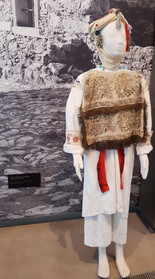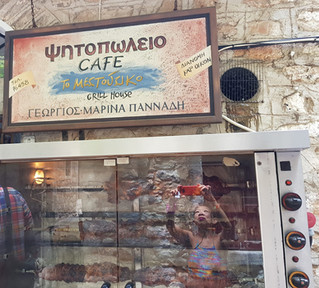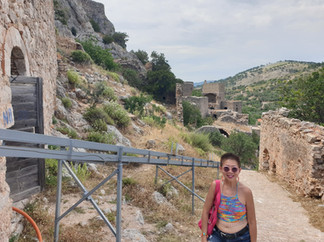Mastic-Masticating My Way through Chios
Time visited: June 2023
Time spent: Two nights
2023 was my Covid revenge year. For starters, I took the whole month of June off to go island-hopping in Greece. I managed to cover 10 islands in a month, two of which were day trips but the rest involved overnight stays.

Chios was my second island. It is the fifth largest Greek island situated in the Northern Aegean Sea. It is only about seven kilometres from Turkiye’s mainland, separated by the Chios Straits. Chios is famously known as the Mastic Island. Mastic is a much sought-after gum obtained from trees that flourish in Chios’ climate. Most people in other parts of the world had never even heard of Chios, let alone know what mastic is.
Anyway, there are heaps of other tourist attractions in Chios which you will be reading about below.
Day 1: Saturday 10 June 2023
Getting there
My travelling partner and I left our first island Lesvos on the Blue Star Ferry at 6.30 am. It took about 3 hours and 15 minutes to sail to Chios. As our accommodation was close enough to the port of Chios, we walked there. The roads in the main town of Chios were so narrow that we really had to be mindful of the traffic, especially the motorbikes that seemed to zoom around.
Our apartment was called GK Apartments. Our hostess was a young Greek girl named Georgia. Our little apartment was a little loft on the first floor. It was tastefully furnished and equipped with all the little touches that made it homely, such as disposable shavers, Q-tips, snacks and coffee. I had paid AUD 182 for two nights there. The apartment also came with a little rooftop balcony where we could sit and relax.
Since we woke up so early, we had a bit of rest and I googled places to have lunch.
Out of luck with two top restaurants in Chios
My first choice was To Kechrimpari Mezedopoulion. It had rave reviews on social media! It was open daily from 12.30 to 4:00 pm only and it was very popular. We made our way there and found it, but alas….a sign on the door said that it was CLOSED for this weekend!!! Just our luck!
Although we were very hungry by this time, we were willing to try another highly recommended restaurant called Hotzas. It boasted Greek cooking with Turkish influence. According to Matt Barrett’s Greece Guides, it was one of the best restaurants on the island.
Guess what? We couldn’t find the building. We phoned and no one answered. We asked a guy in a shop and he said we had already passed it. Hence, we backtracked and found it miserably closed and totally deserted! I was so terribly disappointed by this time. Never before had I picked two top restaurants and found them unavailable.
At the time of writing this in November 2024, Google said that the first restaurant was still operating per normal but the second one was temporarily closed.
We had no choice but to return to the waterfront. We chose Kentpiko Ouzeri Restaurant. We thought it would be a tourist trap, but it turned out to be pretty good. The most obvious thing there were the menus. They were trilingual - Greek, English and Turkish! Because Turkiye was just a stone’s throw away, Chios gets tons of Turkish tourists.
We ordered the island’s regular Horiatiki salad which usually consisted of tomatoes, cucumbers, onions and capsicums with olive oil, vinegar and feta cheese. This one was a bit more special. In addition to all of the above ingredients, it also had pickled seaweed called Kritamo, and capers. Our mains were a seafood pasta with squid, shrimps, prawns and mussels, and a Loukanika (pork sausage) with chips. We enjoyed our meals.
Sightseeing in Chios
After lunch, both of us had a little siesta. Upon waking, we decided to take a 22-minute walk to see the four Ancient Windmills of Chios.
Soon, we caught sight of these famous windmills. They were built on a small jetty at Tampakika, an old industrial zone. They were used to harness the power of the wind to assist with the production of leather in the nearby tanneries in the late 19th and early 20th centuries.
The word ‘ancient’ was used to describe them because they were first constructed in the 14th century when Genoan settlers used them for milling wheat and barley. These stone-built windmills with their distinctive cylindrical shapes and pointed conical roofs created “a visually striking silhouette against the azure backdrop of the Aegean Sea”. They also served “as a testament to the island’s agricultural heritage and the resilience of its people”.
The photos of these windmills taken at sunset looked spectacular in travel brochures, but since I was too early for sunset, I took what I could in the early evening sun. My photos still turned out quite well, I think!
On the walk back, we stopped by a bakery called A La Crème. The lady boss there was very pleasant and gave us an almond cream biscuit each. There was a beautiful mastiha (mastic) cake on display in the cabinet.
Following this, we visited a car rental place in Chios town to make enquiries. We managed to get a small car with Hertz for 40 Euros a day. We needed it tomorrow to go around the island.
Next, we went out to a little restaurant called Dreams. At Dreams, I had the opportunity to taste my first Souma, the potent local liquor. I had read about it with interest earlier. It was distilled from figs and grapes, but it was not commercially bottled. You could request it at restaurants in Chios. At over 40% ABV, the initial taste was very strong, but the fig aftertaste was beautiful and lingering. I had a fried calamari which was fresh and tender. My travelling companion had pork slices.
This was the end of our first day. For tomorrow, I had a list of places that we planned to cover.
Day 2: Sunday 11 June 2023
Tour of Mastic Villages (Mastichochoria)

Based on my research last night, the first place to visit on my priority list was the ancient village of Pyrgi, located in the southern part of this island. It was about a 30-minute drive (25 km) from the town centre.
There were about 20 villages that produced mastic in this region, the biggest one being Pyrgi. These villages banded together to form a mastic union and were known as the Mastichochoria. Because mastic was always in great demand through the centuries, no farmer could simply take time off from mastic cultivation. As such, these villages became self-isolating and eventually developed a subculture and a dialect of their own.
The top three mastic villages were Pyrgi, Mesta and Armolia. There were small tour operators that would take tourists to visit these three villages.
Besides being known as the Mastic Island, Chios is also called the Fragrant Island or Bubble Gum Island due to its prolific mastic gum production. It is a sap produced from the Skinos or mastic tree, which has a very distinguishable (but acquired) flavour.
The Xysta Technique
It didn’t take us long to arrive in Pyrgi using our rented car. Besides being the chief mastic village, there was one other very NOTABLE feature there - that of the beautiful black and white Xysta-etched houses. All the buildings there were distinguished by geometrical black and white motifs which decorated the entire façade of the buildings, including the CHURCHES!
This intricate method of design is known as Xysta or Graffito in Italian. It means ‘scratched’. It was introduced to this island by the Genoans when they invaded Pyrgi in the 13th century.

Xysta is a technique of hand engraving where plastering sand is applied to the stone walls of the houses. The sand could be black, grey, brown or brownish-yellow in colour. A skillful plasterer would apply it to the walls of the entire house. After this, the whole house would be painted white, following which, the geometrical motifs would be carefully scratched or scrapped out with various tools (e.g. a fork), essentially exposing the plastering sand underneath the whitewashed walls. I imagine this to be such a painstakingly time-consuming and tedious process, but the results are amazing!

Pyrgi was also strategically built to resist constant pirate and Turk attacks. Narrow roads and small bridges connected the houses which were built very close to each other, literally shaping a protective wall in every neighbourhood. The narrow streets would all eventually be connected to the main village square.
Many private taxis take tourists here. Chios does not have huge organised daily bus tours. If busloads of tourists arrived, they would inevitably originate from cruise ships.
We had great fun wandering around this fortified village, savouring the aesthetic skill of Xysta-carving. I was well and truly astounded by what I saw. The buildings here were awfully unique and pretty! I had never seen anything like this before! Of course, I took heaps of photographs. Present-day Pyrgi is still very much inhabited. This village is quite touristy with heaps of souvenir shops, cafes, restaurants and little boutiques.
We managed to see all three major churches and the main village square in Pyrgi. Exploring Pyrgi was like visiting a black and white medieval village, a time-travelling experience like no other. I have often wondered why Pyrgi and its timeless houses are so under-promoted on Greek tourism websites. Whenever Greece is mentioned, Mykonos and Santorini immediately pop up in people’s minds. These two islands are too overly-promoted and popular. Lesser but equally impressive islands like Chios deserve the attention too!
The Mastic Museum
Our next stop was Chios Mastic Museum, which is located a mere 10 minutes away from Pyrgi on a hill overlooking the mastic plantations. Every tourist website that I looked up, including Georgia’s recommendation, mentioned that you could not leave Chios without visiting this museum.

It was a thoughtfully constructed building with very clear notes to explain the history and cultivation of mastiha (the Greek word for mastic). Piraeus Bank had poured lots of funds into the construction of this museum. In addition, the mastic cultivation industry has been accepted into UNESCO’s List of Intangible Cultural Heritage of Humanity.
I found the museum to be extremely informative and educational. The reason why the mastic plant thrived in southern Chios was because the farmers here purged out the more inferior species and propagated the growth of the stronger and more resilient species.
Another facet that struck me was the sheer tediousness of the whole process. The mastic tears were left to drip and took between 10 to 20 days to dry, after which they were collected from the ground.

We saw exhibits of the mastic pieces in various stages of cleanliness. The price that mastic farmers received for their mastic harvest depended on how pure they were. The whole mastic cultivation in these villages had evolved into an entire subculture of their own in terms of dialect, dress, social networking and interaction. It became a very close-knit and self-isolating community.
The museum displayed mannequins in various types of traditional clothes. It showed us how oil was extracted from the resin. It also explained to us in great detail how chewing gum was made and exported globally.

There was an outdoor area that featured rows of mastic trees. Visitors saw for themselves what these trees looked like.
My highlight was when we visited the museum’s café. Mastiha coffee was on the menu and so were for types of Mastiha cocktails. My friend tried a mastiha coffee while I had a Spicy Pink cocktail which comprised Mastiha liqueur, vodka, lemon juice, crème de cassis and pink pepper! It was delicious and sour with a hint of the mastic taste.
The café sold tons of mastiha-inspired confectionery. We bought some baklavas, Mandolatas (almond macaroons) and nougat, all with Mastiha thrown in as part of its ingredients.
Mesta, the second mastic village

The second most visited mastic village after Pygri was Mesta. That was our next destination. We planned to have lunch there too. It was about 10 kilometres from the Mastic Museum.
Mesta was considered the best-preserved medieval village of Chios. It was built in the 12th century during the Byzantine era. Similar to Pyrgi, it was built with defensive architecture in mind. Stone houses were constructed attached to one another, forming a fortified wall. Narrow cobbled alleyways wound around the houses like a labyrinth but eventually led to the central square.
The Genoans reinforced the fortifications between 1346 to 1566. Hundreds of villagers from Mesta were killed or captured during the Chios Massacre of 1822 by the Ottoman Turks. However, some of them were eventually released because mastic cultivation was too important to be neglected by the Ottoman Empire.
Mesta was really worth visiting too because it gave us this time-travel feeling of being back in the Middle Ages. It felt more authentic precisely because the old stone houses here weren’t decorated with Xysta motifs like those in Pyrgi. They remained aged and time-worn, providing a very real ambiance of a medieval village.
We settled for lunch at Mestousiko Grill House in the central square. We ordered homemade pasta with roast chicken in a rich tomato sauce. It was scrumptious! In addition, we had a beetroot salad and a paprika cheese dip on the house. Souma, the potent fig and grape distillate, was readily available.
We didn’t visit Armolia, the third mastic village. It is famous for its pottery. We actually drove past Armolia on our way to Pyrgi that morning.
Anavatos, an abandoned medieval stone village on a hill
We headed for Anavatos next. This town was famous for its abandoned stone village perched high up on a mountain. It is about 16 kilometers from Chios town centre.
We could only gasp in astonishment when we first caught sight of this eerily deserted, ghost-like abandoned stone village erected in the 9th century during the Byzantine era. This village was surrounded by enormously high mountains and rocky terrain with dangerous cliffs. We could only wonder how people in the past could ever build houses here at a height of 450 meters above sea level in such a hostile landscape.
The road we were driving on led us to a little village with a restaurant at the bottom of the mountain. Construction work was in progress to preserve this monument, which spoke to us of an ancient past. We climbed uphill a little, past some of these decaying stone houses of bygone centuries.
From a higher position, we got excellent views of the rocky mountains all around us and looked down mind-blowingly at the valleys below the cliffs. It was all rather dizzying. After capturing it on film, we descended to the restaurant at the foothill to enjoy a frappé. We shared a table with an elderly lady who wore dangling earrings and exhibited brightly manicured nails. She chatted with us. Her name was Esmerelda (a common name in Chios). She never married. She has lived in Anavatos all her life and so did her grandfather.
Nea Moni Monastery
Our final destination today was Nea Moni Monastery. It was located on a hilltop 670 meters above sea level. As we drove towards it, we were actually driving on a road higher than where the monastery was located. It offered us a tremendously picturesque view of the monastery. The tall cypress trees surrounding it added to its beauty and serenity.

The monastery was built in 1045 and was listed as a World Heritage Monument by UNESCO in 1991 due to its exceptional position - its art and its direct association with Constantinople and the imperial court. It was a Byzantine monastery. In addition, there was an ossuary containing the skulls and bones of victims who died during the 1822 Ottoman attack on the Chios inhabitants. Villagers from Mesta had come here to seek refuge only to be slaughtered. In short, Nea Moni Monastery was considered the most important Byzantine monument of medieval times on the island of Chios and the Aegean Sea.
We arrived there at 4.30 pm. Due to the siesta hour, the monastery wasn’t open to visitors until 5:00 pm. When we were allowed to enter, we looked around its peaceful garden and peeked inside the church. Naturally, I had to cover my head. I didn’t manage to locate the ossuary. The view from the top of the hill while we were driving there was far nicer compared to being on the grounds of the monastery itself.
Nea Moni Monastery was our last stop. I was extremely pleased that we managed to cover so many places in one day. We took several wrong turns before finally returning the car to Hertz. We also refueled along the way. Upon returning the car, we went back to our apartment, collected our clean laundry and looked for a nice seafood restaurant as we felt like having some fish. We settled for one called The Corner and was served by a rather dense waitress. Unfortunately, we failed to order wisely and ended up with too much fried stuff. Dinner consisted of fried pieces of cod with garlic sauce, fried mushrooms with balsamic vinegar and fried thin strips of zucchini.
Thus, we completed our two-day tour of Chios and sailed off to the island of Samos the next day.























































































Interesting photos. Chios is on my bucket list. How many days would be enough to enjoy the island?
-Cheryl Ramsdell
My family spent a year on Chios island, we enjoyed it! There is so much to discover that (depending on your interests of course) at least a week as a tourist.
-Kristi Cardullo
Interesting. Going to Greece is on my bucket list now. Would have liked to see a picture of the mastic tree...as I love trees and enjoy learning about them.😀🌲
-Geetha
Great ! Reading about Chios was excellent!
I wonder if it has a small or large population!
-Anita
Good on you May.
-Arna